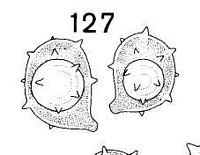|
 Ramariopsis avellanea Ramariopsis avellanea
BiostatusPresent in region - Indigenous. Endemic
Images (click to enlarge)
Caption: Fig. 127. Ramariopsis avellanea. TENN no. 43691. |
Article: Petersen, R.H. (1988). The clavarioid fungi of New Zealand. New Zealand Department of Scientific and Industrial Research, Bulletin 236: 170 pp. Wellington:.
Description: Fruit bodies up to 3 x 1 cm, arbuscular, branched delicately and dichotomously in
2-4 ranks, arising from small whitish mycelial patches. Stipe up to 15 x 2 mm, erect,
purplish tan to pallid dull violet ("vinaceous buff", "wood-brown", "avellaneous"),
terete; lower branches concolourous. Branches terete, upward paler than lower parts
("tilleul buff", "pale pinkish cinnamon"); axils rounded; internodes diminishing
gradually. Apices delicate, short to 3 mm long, awl-shaped. Taste and odour
negligible.
Macrochemical reaction: FCL = weakly grey.
Tramal hyphae of branches hardly inflated, parallel, clamped, hyaline, free.
Subhymenium extensive, pseudoparenchymatous; hymenium hardly thickening;
basidia 24-28 x 6 µm, subcylindrical, hyaline, clamped; sterigmata 4, straight,
spindly. Spores (Fig. 127) 3.6-4.3 x 2.9-3.2 µm (E =1.22-1.50; Em = 1.33; Lm= 4.10
µm), ovate to ellipsoid, hardly roughened, dextrinoid to unreactive in IKI; wall thin;
contents uniguttulate when fresh, but quickly becoming aguttulate; hilar appendix
papillate, prominent; ornamentation of extremely short, sparsely scattered prickles.
Notes: COMMENTARY: Fruit bodies are pigmented from the start, and the final
colouration is close to that of R. pulchella, which is much more strikingly purple.
The small spores are hardly roughened, and appear virtually smooth at x1000.
Spores seem to desiccate quickly, and few are left in the fresh, uniguttulate
condition. Within a single mount in IKI, most spores are non-reactive, but perhaps
one-quarter of them are dextrinoid.
|